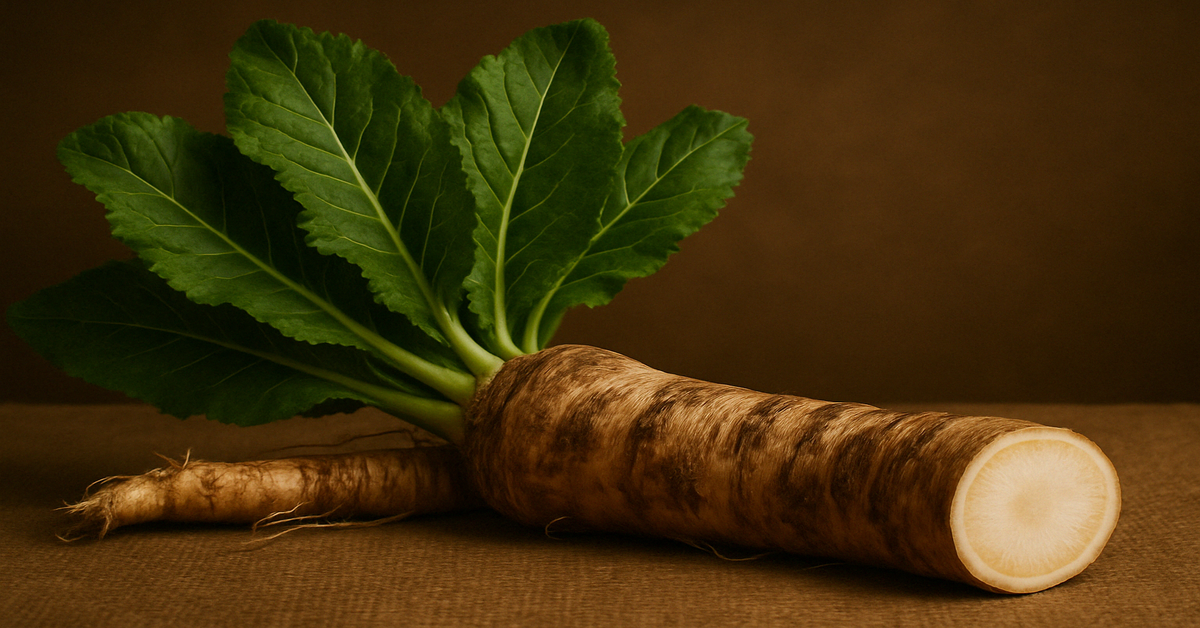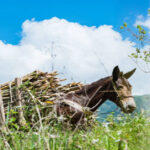What Is Horseradish?
Horseradish is a root vegetable known for its strong, spicy flavor and pungent aroma. Often used as a condiment or seasoning, it belongs to the Brassicaceae family, which includes mustard, wasabi, broccoli, and cabbage. Despite its unassuming appearance, horseradish has played a prominent role in culinary traditions, folk medicine, and agriculture for centuries.
Botanical Background
Plant Classification
- Scientific Name: Armoracia rusticana
- Family: Brassicaceae
- Type: Perennial root vegetable
- Native Region: Southeastern Europe and Western Asia
Horseradish is not just a root but a full plant that includes large, rough leaves and long, tapered roots that store the chemical compounds responsible for its trademark heat.
Growth Characteristics
Horseradish is a hardy perennial that thrives in cooler climates. It prefers well-drained soil, lots of sunlight, and is known for being invasive if not carefully contained. Once planted, horseradish often re-sprouts from leftover root fragments, making it easy to propagate but difficult to remove.
Historical Origins
Ancient Uses
Horseradish has been cultivated since antiquity. The Greeks and Romans used it for both medicinal and culinary purposes. It was thought to relieve pain, treat ailments, and even serve as an aphrodisiac.
Spread Through Europe
In medieval Europe, horseradish became popular in Central and Eastern European cuisine, especially in Germany, Poland, and Russia. It was served with meat dishes and valued for its ability to enhance flavors.
Introduction to the Americas
European immigrants brought horseradish to North America, where it thrived in the Midwest. It is now commercially grown in several U.S. states, especially Illinois, which is known as the “Horseradish Capital of the World.”
Cultivation and Harvesting
Soil and Climate Requirements
Horseradish requires:
- Deep, loose soil for long root development
- Cool temperatures (best planted in spring or fall)
- Plentiful sunlight for optimal growth
The roots grow deep and wide, so spacing and containment are critical in home gardens.
Planting Method
Typically, horseradish is propagated by planting root cuttings (called “sets”) from a mother plant. These cuttings are placed at an angle in the ground and covered with soil. Over time, the cutting develops a primary root and side shoots.
Harvest Time
Horseradish is usually harvested in late fall, after the first frost, which enhances the root’s pungency. The entire plant is dug up, and large, central roots are saved for processing while smaller offshoots can be replanted.
Processing and Storage
Grating and Preparation
Fresh horseradish root must be peeled and grated to release its sharp flavor. The pungent kick comes from allyl isothiocyanate, a compound produced when the root’s cells are broken down.
Grated horseradish is highly volatile and should be processed in a well-ventilated area or with protective eyewear.
Preserving Flavor
Once grated, horseradish begins to lose potency. It can be mixed with:
- Vinegar – to stabilize the sharpness
- Salt – for flavor enhancement
- Sugar – to mellow the heat
Refrigerated, it lasts up to two months in a sealed container. Freezing is also possible, but it may change texture.
Culinary Uses
As a Condiment
Horseradish is most commonly used as a spicy condiment, served alongside:
- Roast beef
- Smoked fish
- Sandwiches
- Sausages
Mixed with vinegar, it forms traditional horseradish sauce, often white and creamy in color when blended with mayonnaise or sour cream.
Ingredient in Prepared Dishes
Horseradish adds a kick to:
- Deviled eggs
- Mashed potatoes
- Bloody Mary cocktails
- Horseradish butter or aioli
- Pickled beets or slaws
It is also an ingredient in wasabi substitutes in many commercial sushi preparations, as real wasabi is rare and expensive.
Cultural Cuisines
- Eastern European: Served with gefilte fish, meats, and in borscht
- Jewish cuisine: Integral to Passover Seder as a bitter herb (maror)
- British cuisine: Served with roast beef and Yorkshire pudding
- Japanese cuisine: Used as a substitute for wasabi in many cases
Medicinal and Nutritional Properties
Nutritional Content
Horseradish is low in calories but rich in:
- Vitamin C
- Folate
- Calcium
- Potassium
- Dietary fiber
It is typically consumed in small amounts, so while not a major nutrient source, it contributes beneficial compounds.
Health Benefits
Horseradish has long been used in traditional medicine. Some potential benefits include:
- Antimicrobial properties: Due to compounds like allyl isothiocyanate
- Respiratory relief: Acts as a natural decongestant
- Digestive aid: Stimulates appetite and gastric activity
- Anti-inflammatory effects: Studied for joint pain and muscle soreness
Cautions and Sensitivities
- Consuming large amounts can irritate the digestive tract
- May trigger allergic reactions
- Should be avoided by individuals with ulcers or kidney disorders
Horseradish vs. Wasabi
Botanical Differences
Though often used interchangeably, wasabi and horseradish are distinct plants:
- Wasabi (Wasabia japonica): Native to Japan; grows in mountain streams
- Horseradish (Armoracia rusticana): Grows in soil; hardier and easier to cultivate
Flavor Comparison
Wasabi has a smoother, fresher heat with a green color, while horseradish is sharper and more pungent, typically white in color. Most commercial wasabi products are made from horseradish due to cost and accessibility.
Industrial and Commercial Use
Processing Industry
Horseradish is processed in:
- Jars (grated in vinegar)
- Prepared sauces (creamy blends)
- Powdered or dehydrated form
It is widely used in commercial kitchens and food service, particularly in meat and seafood dishes.
Global Trade
Horseradish is cultivated commercially in:
- United States (Illinois, Wisconsin)
- Germany
- Hungary
- Russia
It is sold domestically and exported for culinary and industrial use.
Horseradish in Culture and Symbolism
Folklore and Tradition
In many cultures, horseradish is associated with:
- Protection from evil spirits
- Fertility rituals
- Medicinal brews and tonics
Its strong smell and flavor made it symbolic of strength, endurance, and purification.
In Religion
In Jewish tradition, horseradish is often eaten during the Passover Seder as one of the bitter herbs symbolizing the hardships of slavery in Egypt.
Growing Horseradish at Home
Planting Guide
- Best planted in early spring
- Use root cuttings, planting them 2–3 inches deep at a slant
- Water regularly but avoid soggy soil
Harvest Tips
- Harvest after first frost in late autumn
- Use a spade or fork to dig around the main root
- Replant offshoots for the next season
Storage Methods
- Store roots in root cellars or refrigerators
- Keep unwashed, wrapped in damp cloth or sand
- Can last several months when stored properly
Common Varieties
Maliner Kren
A traditional Eastern European horseradish known for intense flavor and robust growth, often favored in Slavic cuisine.
Bohemian
One of the most cultivated varieties in the U.S., it’s known for consistent growth and commercial use.
Wild Horseradish
Grows along riverbanks and fields. While edible, flavor and texture may vary widely.
Environmental and Economic Impact
Invasive Potential
Horseradish can become invasive in gardens if not managed. It reproduces through root fragments, making it difficult to eradicate once established.
Economic Crop
In commercial settings, horseradish contributes to local economies and agricultural diversity. Small and mid-sized farms often include horseradish as a high-value crop with low maintenance needs.
Future of Horseradish
Culinary Trends
As interest in bold flavors grows, horseradish is being reimagined in:
- Craft sauces
- Vegan recipes
- Gourmet condiments
Its ability to mimic wasabi keeps it relevant in fusion cuisine and sushi culture.
Scientific Study
Ongoing research is exploring horseradish compounds for:
- Antioxidant properties
- Natural preservatives
- Biological pest control agents
Its rich chemical profile may inspire innovations in health and agriculture.
Conclusion
Horseradish, often underestimated due to its rustic look, holds a place of honor in both kitchens and gardens around the world. From ancient medicine to gourmet plating, this root vegetable continues to command attention for its bold flavor, storied history, and surprising versatility.
Whether grated fresh, served in creamy sauces, or used in cultural rituals, horseradish adds spice—literally and symbolically—to the human experience. Its resilience in the field and pungency on the plate make it a root worth knowing and growing.
FAQs
1. Is horseradish the same as wasabi?
No. Horseradish and wasabi are different plants, though horseradish is often used as a wasabi substitute due to its similar pungency and lower cost.
2. Can I grow horseradish at home?
Yes. Horseradish is a hardy plant that thrives in cool climates and well-drained soil. It’s easy to grow from root cuttings.
3. Is horseradish healthy to eat?
In small amounts, yes. It contains Vitamin C, antioxidants, and has antimicrobial properties. However, it should be eaten in moderation due to its potency.
4. Why does horseradish burn your nose?
When grated, horseradish releases volatile compounds like allyl isothiocyanate, which irritate nasal passages—similar to mustard or wasabi.
5. How do I store fresh horseradish root?
Store unwashed roots in a cool, dark place like a refrigerator or cellar. Wrap them in a damp cloth or sand for moisture control.
6. What dishes use horseradish?
Horseradish is used in sauces, meats, fish dishes, mashed potatoes, and cocktail recipes like Bloody Marys. It’s also a traditional condiment in Eastern European and Jewish cuisine.











